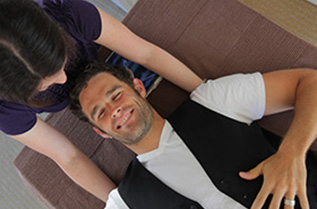What can The Alexander Technique help you achieve?
Less Pain, Less Stress, More Energy.
The Alexander Technique is not a therapy, but an educational process.It is not meant to replace treatment from a physician, physical therapist, psychologist, chiropractor, or acupuncturist, but to augment these and other modalities in order to provide well rounded, balanced care.
 Most of us walk around unconscious of how we move through our daily lives. We put all our attention on the goal (“I’m going to get this project done tonight no matter what it takes!”) and ignore how we get there. In pushing ourselves like this, we create stress and develop harmful postural or movement patterns that throw our bodies out of balance and weaken our structures as a whole. When our systems are compromised, it only takes one wrong step and a little twist to cause pain or a serious injury. This is where the Alexander Technique comes in. By working with an Alexander teacher, you become aware of the things you are doing that might be causing your discomfort. You learn to release tension while working at a computer, driving your car, or giving a high stakes presentation. Within one session, students of this technique report feeling lighter, more focused, and more energized.
Most of us walk around unconscious of how we move through our daily lives. We put all our attention on the goal (“I’m going to get this project done tonight no matter what it takes!”) and ignore how we get there. In pushing ourselves like this, we create stress and develop harmful postural or movement patterns that throw our bodies out of balance and weaken our structures as a whole. When our systems are compromised, it only takes one wrong step and a little twist to cause pain or a serious injury. This is where the Alexander Technique comes in. By working with an Alexander teacher, you become aware of the things you are doing that might be causing your discomfort. You learn to release tension while working at a computer, driving your car, or giving a high stakes presentation. Within one session, students of this technique report feeling lighter, more focused, and more energized.
Clinical studies have demonstrated that a few lessons in the Alexander Technique may have a positive effect on everything from back pain to Parkinson’s Disease to respiratory muscular function. A 2010 study conducted at the Cincinnati Children’s Hospital shows how Alexander Technique appears to, “enhance the posture and proficiency of surgeons who perform minimally invasive procedures.”
We’ve included some recent articles and links to studies below. For more information or to request free literature, contact us.
Recent Articles & Medical Studies
Exploratory study in the UK reveals the benefit of Alexander Technique lessons for chronic pain. The National Health Service (NHS) is now supporting Alexander Technique sessions at outpatient pain clinics in England and the results are in…
Article: Overcoming Pain by Dr. Mark Borigini. Read what a board-certified rheumatologist who has devoted his career to treating a wide variety of illnesses that cause chronic pain and disability has to say about Alexander Technique in Psychology Today.
 Health Alert: Knee Osteoarthritis study demonstrates benefits from the Alexander Technique.
Health Alert: Knee Osteoarthritis study demonstrates benefits from the Alexander Technique.
Article: Interview with Judith C. Stern, MA PT in Spine Health magazine.
Article: The Psychological Benefits of the Alexander Technique: A Personal Story By Adam Bailey
Article: Chronic Pain: How the Alexander Technique Can Help by Joan Arnold & Hope Gillerman with Terry Zimmerer
Article: The Alexander Technique and Parkinson’s Disease: A Case Study in Generating Hope for a Degenerative Condition.
Article: Applying Ergonomic Principles in the Workplace.
Article: New York Times writer Lesley Alderman writes about how Alexander Technique can help with back pain.
Article: Pregnancy and Child birth with the Alexander Technique
Listen: Shirley Wade-Linton, an Alexander Technique teacher and registered dietitian in Courtenay, Vancouver Island, British Columbia talks with Robert Rickover about ways in which Alexander Technique can help people with eating disorders.
Listen: NPR’s Morning Edition talks with Josephine Grey, an Alexander Teacher in San Francisco.
British Medical Journal back pain study
The Impact of the Alexander Technique in Improving (the surgeon’s) Posture during Minimally Invasive Surgery – A 2010 study conducted at the Cincinnati Children’s Hospital, Cincinnati, Ohio.
For more on this study Click Here
Randomized Controlled Trial of the Alexander Technique for Idiopathic Parkinson’s Disease
Testimonials
“Lessons in the Alexander Technique taught me how to sit in a state of lumbrosacral poise, and my chronic low back pain gradually became cured. The Alexander Technique is true education. Compared to surgery (e.g. for low back pain or for chronic obstructive lung disease) a course of instruction is inexpensive.”
“The Alexander Technique remains the best of the self-care strategies to prevent the sequel of poor posture and poor breathing.”
“The Alexander Technique has been very helpful in identifying the postural and breathing habits that contribute to my fatigue and muscle soreness. I found it a good value: cost effective, making me less dependent on chiropractors and more comfortable at work.”
“I fell and suffered a compression fracture of the back. Upon recommendation of a fellow therapist, I started treatment in the Alexander Technique. I have noticed not only a steady reduction of pain, but improvement in my general flexibility, balance and bearing. I use the Technique in conjunction with other physical exercise, and have found no contraindications.”
“In addition to its physiologic and musculoskeletal benefits, the Alexander Technique is extremely helpful in relieving the psychological states of depression and anxiety that so often accompany chronic pain and disease. It is my belief, based on professional experience, that the Alexander Technique should be part of all preventative health and education programs. It is as basic as good nutrition.”
“The Alexander Technique makes sense in that appropriate use of the body will lead to reduction of various musculoskeletal disorders and remediate others which are established. No equipment is needed, just the skill and training of the teacher. This technique is very worthwhile as a primary preventative therapy. It is especially useful when posture is a key factor in back injuries while lifting and for workers who perform repetitive tasks while sitting.”





